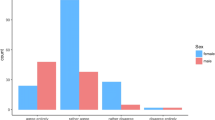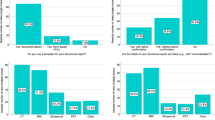Abstract
In 2010 the International Atomic Energy Agency launched the “3 A’s campaign”: Audit, Appropriateness and Awareness for radiological justification, which is an effective tool for cancer prevention. Cardiologists prescribe the majority of radiological testing, but their awareness of doses and risks of ionizing cardiac imaging test is low. To assess radioprotection awareness of prescribing and practicing physicians (mainly cardiologists) before and after a radioprotection course. We held a 1-day 6-h primer of radioprotection for a limited number (20–35) of physicians. The course offered 8 continuing education credits from the Italian Health Ministry and was held 9 times over 3 years. We had 425 attendees, but full data sets (with complete questionnaires) were available for 403 physicians (55% women, age 45 ± 6 years), including 55% cardiologists, 40% general practitioners, 5% others (mainly cardiology fellows). For each attendee, a radiological awareness score was obtained before and after the course, with a survey containing 10 multiple-choice questions (5 answers) on radioprotection basics (doses of common examinations in multiples of chest x-rays; associated cancer risk, etc.). Each answer was scored from 0 (“don’t know”), 1 (“strongly disagree”) to 4 (“strongly agree”). The radiological awareness score of the 403 attendees improved from 31 ± 3 (before) to 37 ± 2 (after training, P < 0.001 vs. pre-training). As an example, before training, 25% of attendees believed that radiation-induced cancer risk disappears after 6 months (10% of respondents), 12 months (8%) or 5 years (7%), whereas 75% (becoming 98% after training) correctly estimated that radiological damage is cumulative over one’s lifetime. Awareness of radiological doses and risks, albeit essential for risk–benefit assessment of radiological testing, is suboptimal among cardiologists, but can dramatically improve with a limited teaching effort through targeted training.


Similar content being viewed by others
References
FDA Unveils Initiative to Reduce Unnecessary Radiation Exposure from Medical Imaging. http://www.fda.gov/newsevents/newsroom/pressannouncements/ucm200085.htm
Picano E (2004) Sustainability of medical imaging. Education and debate. BMJ 328:578–580
Mettler FA Jr, Thomadsen BR, Bhargavan M, Gilley DB, Gray JE, Lipoti JA, McCrohan J, Yoshizumi TT, Mahesh M (2008) Medical radiation exposure in the US in 2006: preliminary results. Health Phys 95:502–507
Berrington de González A, Mahesh M, Kim KP, Bhargavan M, Lewis R, Mettler F, Land C (2009) Projected cancer risks from computed tomographic scans performed in the United States in 2007. Arch Intern Med 169:2071–2077
Picano E (2004) Risk of cancer from diagnostic X-rays. Lancet 363:1909–1910
Brenner DJ (2009) Extrapolating radiation-induced cancer risks from low doses to very low doses. Health Phys 97:505–509
Malone J, Craven C, Guliera R, Horton P, Järvinen H, Mayo J, O’Reilly G, Picano E, Remedios D (2011) Justification of diagnostic medical exposures, some practical issues. Report of an International Atomic Energy Agency (IAEA) Consultation. Br J Radiol. February 22
Gerber TC, Carr JJ, Arai AE, Dixon RL, Ferrari VA, Gomes AS, Heller GV, McCollough CH, McNitt-Gray MF, Mettler FA, Mieres JH, Morin RL, Yester MV (2009) Ionizing radiation in cardiac imaging: a science advisory from the American Heart Association Committee on Cardiac Imaging of the Council on Clinical Cardiology and Committee on Cardiovascular Imaging and Intervention of the Council on Cardiovascular Radiology and Intervention. Circulation 119:1056–1065
Brindis R, Douglas PS (2010) President’s page: the ACC encourages multi-pronged approach to radiation safety. J Am Coll Cardiol 56:522–524
Vañó E, González L, Guibelalde E, Fernández JM, Ten JI (1998) Radiation exposure to medical staff in interventional and cardiac radiology. Br J Radiol 71:954–960
Hirshfeld JW Jr, Balter S, Brinker JA, Kern MJ, Klein LW, Lindsay BD, Tommaso CL, Tracy CM, Wagner LK (2005) ACCF/AHA/HRS/SCAI clinical competence statement on physician knowledge to optimize patient safety and image quality in fluoroscopically guided invasive cardiovascular procedures: a report of the American College of Cardiology Foundation/American Heart Association/American College of Physicians Task Force on Clinical Competence and Training. Circulation 111:511–532
Correia MJ, Hellies A, Andreassi MG, Ghelarducci B, Picano E (2005) Lack of radiological awareness among physicians working in a tertiary-care cardiological centre. Int J Cardiol 103:307–311
Lattanzi F, Magnani M, Cortigiani L, Mandorla S, Zuppiroli A (2002) Evaluation of appropriateness of prescribing echocardiography. Italian Heart J 3:613–618
Herzog P, Rieger CT (2004) Risk of cancer from diagnostic X-rays. Lancet 363:340–341
Pennell DJ, Sechtem UP, Higgins CB, Manning WJ, Pohost GM, Rademakers FE, van Rossum AC, Shaw LJ, Yucel EK (2004) Society for Cardiovascular Magnetic Resonance; Working Group on Cardiovascular Magnetic Resonance of the European Society of Cardiology: Clinical indications for cardiovascular magnetic resonance [CMR]: Consensus Panel report. Eur Heart J 25:1940–1965
Committee to Assess Health Risks from Exposure to Low Levels of Ionizing Radiation. Health risks from exposure to low levels of ionizing radiation: BEIR VII Phase 2. Washington, DC: The National Academies Press; 2006. Available at: http://books.nap.edu/openbook.php?record_id=11340&page=R1
European Commission on Radiation Protection 118: Referral guidelines for imaging. http://ec.europa.eu/energy/nuclear/radioprotection/publication/doc/118_en.pdf
UNSCEAR 2008 Report: “Sources and effects of ionizing radiation”. Volume I. http://www.unscear.org/docs/reports/2008/09-86753_Report_2008_Annex_A.pdf
Council Directive 97/43/Euratom of 30 June 1997 on health protection of individuals against the dangers of ionizing radiation in relation to medical exposure, and repealing Directive 84/466/Euratom. Official Journal L 180, 09/07/1997 P. 0022–0027
Patel MR, Spertus JA, Brindis RG, Hendel RC, Douglas PS, Peterson ED, Wolk MJ, Allen JM, Raskin IE (2005) ACCF proposed method for evaluating the appropriateness of cardiovascular imaging. J Am Coll Cardiol 46:1606–1613
Picano E, Pasanisi E, Brown J, Marwick TH (2007) A gatekeeper for the gatekeeper: inappropriate referrals to stress echocardiography. Am Heart J 154:285–290
Gibbons RJ, Miller TD, Hodge D, Urban L, Araoz PA, Pellikka P, McCully RB (2008) Application of appropriateness criteria to stress single-photon emission computed tomography sestamibi studies and stress echocardiograms in an academic medical center. J Am Coll Cardiol 51:1283–1289
Ayyad AE, Cole J, Syed A, Desai MY, Halliburton S, Schoenhagen P, Flamm SD, Sola S (2009) Temporal trends in utilization of cardiac computed tomography. J Cardiovasc Comput Tomogr 3:16–21
Shiralkar S, Rennie A, Snow M, Galland RB, Lewis MH, Gower-Thomas K (2003) Doctors’ knowledge of radiation exposure: questionnaire study. BMJ 327:371–372
Lee CI, Haims AH, Monico EP, Brink JA, Forman HP (2004) Diagnostic CT scans: assessment of patient, physician, and radiologist awareness of radiation dose and possible risks. Radiology 231:393–398
Thomas KE, Parnell-Parmley JE, Haidar S, Moineddin R, Charkot E, BenDavid G, Krajewski C (2006) Assessment of radiation dose awareness among pediatricians. Pediatr Radiol 36:823–832
Krille L, Hammer GP, Merzenich H, Zeeb H (2010) Systematic review on physician’s knowledge about radiation doses and radiation risks of computed tomography. Eur J Radiol 76:36–41
Amis ES Jr, Butler PF, Applegate KE, Birnbaum SB, Brateman LF, Hevezi JM, Mettler FA, Morin RL, Pentecost MJ, Smith GG, Strauss KJ, Zeman RK (2007) American College of Radiology white paper on radiation dose in medicine. J Am Coll Radiol 4:272–284
Lauer MS (2009) Elements of danger—the case of medical imaging. N Engl J Med 361:841–843
President’s Cancer Panel: Environmentally caused cancers are “grossly underestimated” and “needlessly devastate American lives”. http://www.environmentalhealthnews.org/ehs/news/presidents-cancer-panel
Euratom basic safety Standard Directive 2012 http://ec.europa.eu/energy/nuclear/radiation_protection/doc/art31/2010_02_24_draft_euratom_basic_safety_standards_directive.pdf
Vañó E, González L, Fernández JM, Alfonso F, Macaya C (2006) Occupational radiation doses in interventional radiology: a 15-year follow-up. Br J Radiol 19:237–244
Picano E (2004) Informed consent and communication of risk from radiological and nuclear medicine examinations: how to escape from a communication inferno. BMJ 329:849–851
Acknowledgments
The study was funded by the SUIT-Heart (Stop Useless Imaging Testing in Heart disease) grant of Istituto Toscana Tumori, and co-funded by an unrestricted scientific grant of Banca Popolare del Cassinate for economic sustainability of medical testing.
Conflict of interest
We declare that does not exist conflict of interest.
Author information
Authors and Affiliations
Corresponding author
Rights and permissions
About this article
Cite this article
Carpeggiani, C., Kraft, G., Caramella, D. et al. Radioprotection (un)awareness in cardiologists, and how to improve it. Int J Cardiovasc Imaging 28, 1369–1374 (2012). https://doi.org/10.1007/s10554-011-9937-8
Received:
Accepted:
Published:
Issue Date:
DOI: https://doi.org/10.1007/s10554-011-9937-8




